-
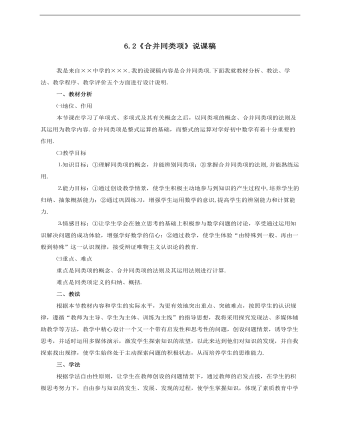
初中数学冀教版七年级上册《62合并同类项》说课稿
㈡教学目标⒈知识目标:①理解同类项的概念,并能辨别同类项;②掌握合并同类项的法则,并能熟练运用.⒉能力目标:①通过创设教学情景,使学生积极主动地参与到知识的产生过程中,培养学生的归纳、抽象概括能力;②通过巩固练习,增强学生运用数学的意识,提高学生的辨别能力和计算能力.⒊情感目标:①让学生学会在独立思考的基础上积极参与数学问题的讨论,享受通过运用知识解决问题的成功体验,增强学好数学的信心;②通过教学,使学生体验“由特殊到一般、再由一般到特殊”这一认识规律,接受辩证唯物主义认识论的教育.
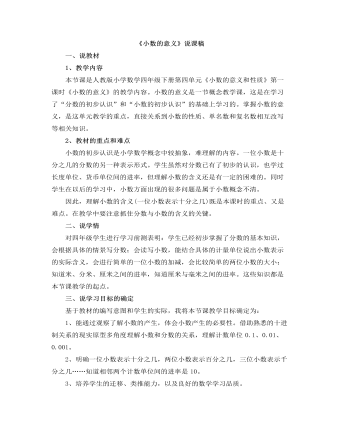
小学数学人教版四年级下册 《小数的意义》说课稿
1、教学内容本节课是人教版小学数学四年级下册第四单元《小数的意义和性质》第一课时《小数的意义》的教学内容。小数的意义是一节概念教学课,这是在学习了“分数的初步认识”和“小数的初步认识”的基础上学习的。掌握小数的意义,是这单元教学的重点,直接关系到小数的性质、单名数和复名数相互改写等相关知识。 2、教材的重点和难点小数的初步认识是小学数学概念中较抽象,难理解的内容。一位小数是十分之几的分数的另一种表示形式。学生虽然对分数已有了初步的认识,也学过长度单位、货币单位间的进率,但理解小数的含义还是有一定的困难的。同时学生在以后的学习中,小数方面出现的很多问题是属于小数概念不清。因此,理解小数的含义(一位小数表示十分之几)既是本课时的重点、又是难点。在教学中要注意抓住分数与小数的含义的关键。
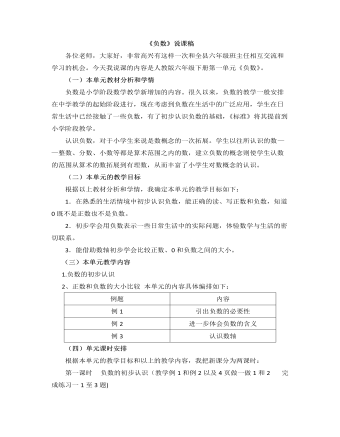
小学数学人教版六年级下册《负数》说课稿
(一)本单元教材分析和学情负数是小学阶段数学教学新增加的内容。很久以来,负数的教学一般安排在中学教学的起始阶段进行,现在考虑到负数在生活中的广泛应用,学生在日常生活中已经接触了一些负数,有了初步认识负数的基础,《标准》将其提前到小学阶段教学。认识负数,对于小学生来说是数概念的一次拓展。学生以往所认识的数——整数、分数、小数等都是算术范围之内的数,建立负数的概念则使学生认数的范围从算术的数拓展到有理数,从而丰富了小学生对数概念的认识。(二)本单元的教学目标根据以上教材分析和学情,我确定本单元的教学目标如下:1.在熟悉的生活情境中初步认识负数,能正确的读、写正数和负数,知道0既不是正数也不是负数。2.初步学会用负数表示一些日常生活中的实际问题,体验数学与生活的密切联系。
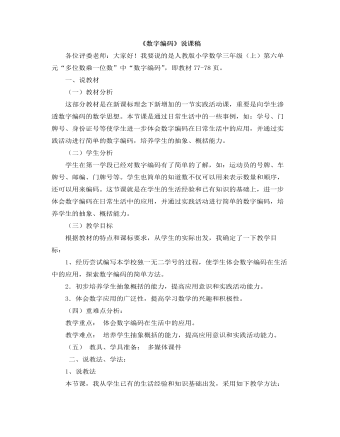
小学数学人教版三年级上册《数字编码》说课稿
一、说教材(一)教材分析这部分教材是在新课标理念下新增加的一节实践活动课,重要是向学生渗透数字编码的数学思想。本节课是通过日常生活中的一些事例,如:学号、门牌号、身份证号等使学生进一步体会数字编码在日常生活中的应用,并通过实践活动进行简单的数字编码,培养学生的抽象、概括能力。(二)学生分析学生在第一学段已经对数字编码有了简单的了解,如:运动员的号牌、车牌号、邮编、门牌号等。学生也简单的知道数不仅可以用来表示数量和顺序,还可以用来编码。这节课就是在学生的生活经验和已有知识的基础上,进一步体会数字编码在日常生活中的应用,并通过实践活动进行简单的数字编码,培养学生的抽象、概括能力。(三)教学目标根据教材的特点和课标要求,从学生的实际出发,我确定了一下教学目标: 1、经历尝试编写本学校独一无二学号的过程,使学生体会数字编码在生活中的应用,探索数字编码的简单方法。 2.初步培养学生抽象概括的能力,提高应用意识和实践活动能力。 3.体会数字应用的广泛性,提高学习数学的兴趣和积极性。
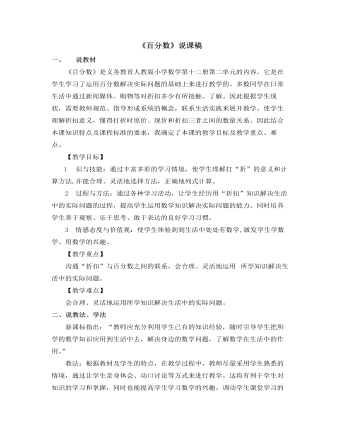
小学数学人教版六年级下册《百分数(二)》说课稿
一、 说教材《百分数》是义务教育人教版小学数学第十二册第二单元的内容。它是在学生学习了运用百分数解决实际问题的基础上来进行教学的。多数同学在日常生活中通过新闻媒体、购物等对折扣多少有所接触、了解。因此根据学生现状,需要教师规范、指导形成系统的概念,联系生活实践来展开教学。使学生理解折扣意义,懂得打折时原价、现价和折扣三者之间的数量关系。因此结合本课知识特点及课程标准的要求,我确定了本课的教学目标及教学重点、难点。【教学目标】⒈ 识与技能:通过丰富多彩的学习情境,使学生理解打“折”的意义和计算方法,并能合理、灵活地选择方法,正确地列式计算。⒉ 过程与方法:通过各种学习活动,让学生经历用“折扣”知识解决生活中的实际问题的过程,提高学生运用数学知识解决实际问题的能力。同时培养学生善于观察、乐于思考、敢于表达的良好学习习惯。⒊ 情感态度与价值观:使学生体验到到生活中处处有数学,激发学生学数学、用数学的兴趣。【教学重点】沟通“折扣”与百分数之间的联系,会合理、灵活地运用 所学知识解决生活中的实际问题。【教学难点】会合理、灵活地运用所学知识解决生活中的实际问题。
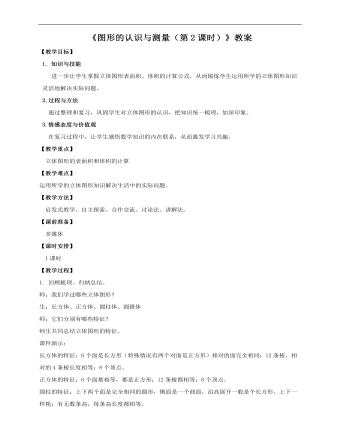
小学数学人教版六年级下册《第五课图形的认识与测量(第2课时)》教案说课稿
【课时安排】 1课时【教学过程】1.回顾梳理、归纳总结。师:我们学过哪些立体图形?生:长方体、正方体、圆柱体、圆锥体师:它们分别有哪些特征?师生共同总结立体图形的特征。 课件演示:长方体的特征:6个面是长方形(特殊情况有两个对面是正方形)相对的面完全相同;12条棱,相对的4条棱长度相等;8个顶点。正方体的特征:6个面都相等,都是正方形;12条棱都相等;8个顶点。圆柱的特征:上下两个面是完全相同的圆形,侧面是一个曲面,沿高展开一般是个长方形。上下一样粗;有无数条高,每条高长度都相等。
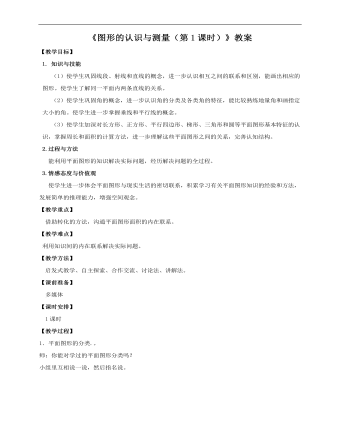
小学数学人教版六年级下册《第五课图形的认识与测量(第1课时)》教案说课稿
2.三角形的分类。师:你能给三角形按照不同的标准进行分类吗?生用自己喜欢的方式整理分类,然后汇报:生:三角形按角分为锐角三角形、直角三角形、钝角三角形。师:什么是锐角三角形、直角三角形、钝角三角形?生:三个角都是锐角的三角形叫做锐角三角形;有一个角是直角的三角形叫做直角三角形;有一个角是钝角的三角形叫做钝角三角形。生:三角形按边分为不等边三角形(三条边都不相等)、等腰三角形(等边三角形) 等腰三角形的两条边相等,等边三角形的三条边都相等。3.四边形分类。师:你能给四边形分类吗?生:四边形分为平行四边形和梯形;平行四边形包括长方形和正方形,长方形又包括正方形;梯形包括等腰梯形和直角梯形。4.直线、射线和线段的关系。小组内互相交流,然后汇报:
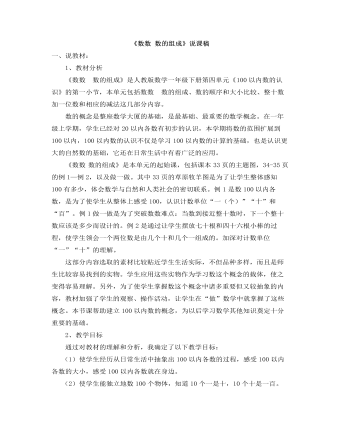
小学数学人教版一年级下册《数数 数的组成》说课稿
1、教材分析《数数 数的组成》是人教版数学一年级下册第四单元《100以内数的认识》的第一小节,本单元包括数数 数的组成、数的顺序和大小比较、整十数加一位数和相应的减法这几部分内容。数的概念是整座数学大厦的基础,是最基础、最重要的数学概念。在一年级上学期,学生已经对20以内各数有初步的认识,本学期将数的范围扩展到100以内,100以内数的认识不仅是学习100以内数的计算的基础,也是认识更大的自然数的基础,它还在日常生活中有着广泛的应用。《数数 数的组成》是本单元的起始课,包括课本33页的主题图,34-35页的例1—例2,以及做一做。其中33页的草原牧羊图是为了让学生整体感知100有多少,体会数学与自然和人类社会的密切联系。例1是数100以内各数,是为了使学生从整体上感受100,认识计数单位“一(个)”“十”和“百”。例1做一做是为了突破数数难点:当数到接近整十数时,下一个整十数应该是多少而设计的。例2是通过让学生摆放七十根和四十六根小棒的过程,使学生领会一个两位数是由几个十和几个一组成的。加深对计数单位“一”“十”的理解。
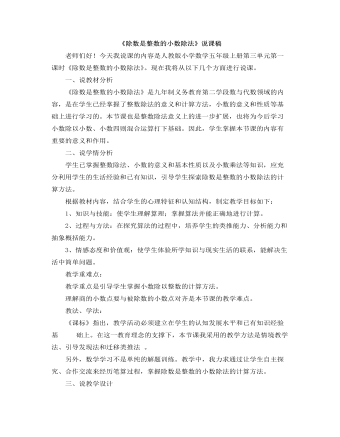
小学数学人教版五年级上册《除数是整数的小数除法》说课稿
一、说教材分析 《除数是整数的小数除法》是九年制义务教育第二学段数与代数领域的内容,是在学生已经掌握了整数除法的意义和计算方法,小数的意义和性质等基础上进行学习的。本节课也是整数除法意义上的进一步扩展,也将为今后学习小数除以小数、小数四则混合运算打下基础。因此,学生掌握本节课的内容有重要的意义和作用。 二、说学情分析学生已掌握整数除法、小数的意义和基本性质以及小数乘法等知识,应充分利用学生的生活经验和已有知识,引导学生探索除数是整数的小数除法的计算方法。 根据教材内容,结合学生的心理特征和认知结构,制定教学目标如下: 1、知识与技能:使学生理解算理;掌握算法并能正确地进行计算。 2、过程与方法:在探究算法的过程中,培养学生的类推能力、分析能力和抽象概括能力。 3、情感态度和价值观:使学生体验所学知识与现实生活的联系,能解决生活中简单问题。
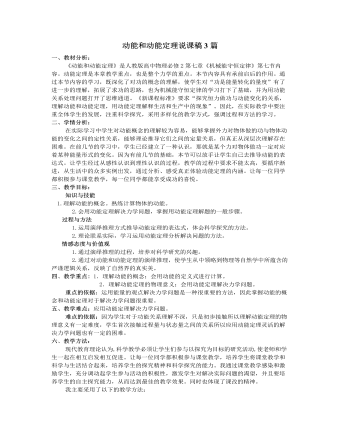
人教版新课标高中物理必修2动能和动能定理说课稿3篇
2、教学目标根据我对教材的理解、结合学生的实际情况、渗透新课程的教学理念,为提高全体学生的科学素养,按课程标准,以促进全体学生发展为目的。从知识与技能、过程与方法,情感态度与价值观三个方向培养学生,拟定三个教学目标:知识与技能:(1)知道什么是动能。(2)正确理解和运用动能公式分析、解答有关问题。(3)掌握外力对物体所做的总功的计算,理解“代数和”的含义。(4)理解和运用动能定理。过程与方法:通过演绎推理过程,培养科学研究兴趣,领略物理学中所蕴含的严谨的逻辑关系。情感、态度、价值观:通过运用动能定理分析解决问题,感受成功的喜悦,培养学生对科学研究的兴趣。3、教学的重点和难点重点:理解动能定理、应用动能定理解决力学问题。难点:应用动能定理解决多个过程的力学问题,以及变力做功或曲线运动中的动能定理运用。
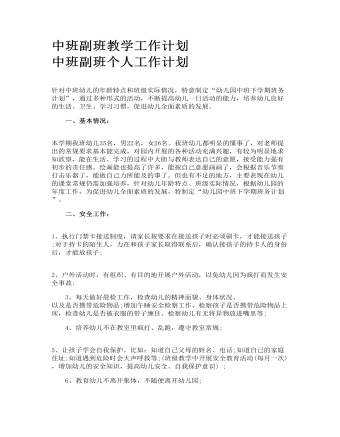
中班副班个人工作计划
1、执行门禁卡接送制度,请家长按要求在接送孩子时必须刷卡,才能接送孩子;对于持卡的陌生人,力在和孩子家长取得联系后,确认接孩子的持卡人的身份后,才能放孩子; 2、户外活动时,有组织、有目的地开展户外活动,以免幼儿因为疯打而发生安全事故; 3、每天做好晨检工作,检查幼儿的精神面貌、身体状况、 以及是否携带危险物品;增加午睡安全检察工作、检察孩子是否携带危险物品上床,检查幼儿是否被衣服的带子缠住、检察幼儿有无将异物放进嘴里等;
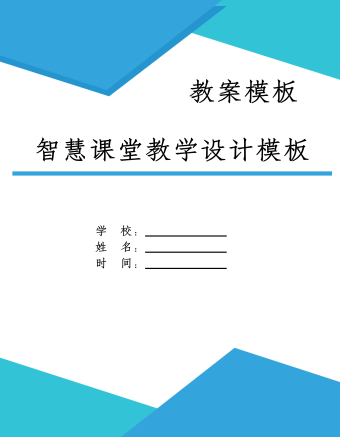
分式方程的解法及应用教学设计与学案
内容:分式方程的解法及应用——初三中考数学第一轮复习学习目标:1、熟练利用去分母化分式方程为整式方程2、熟练利用分式方程的解法解决含参数的分式方程的问题重点:分式方程的解法(尤其要理解“验”的重要性)难点:含参数的分式方程问题预习内容:1、观看《分式方程的解法》《含参数分式方程增根问题》《解含参分式方程》视频2、完成预习检测
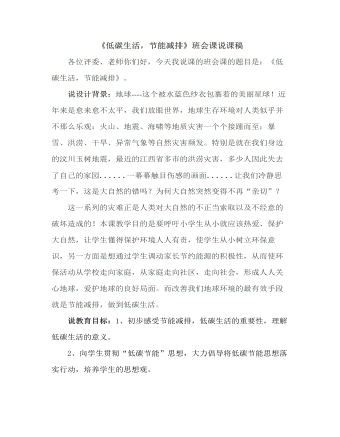
《低碳生活,节能减排》班会课说课稿
说活动重点和难点:理解低碳节能的意义,使学生低碳节能的思想落实到行动。说活动准备:教师制作课件说活动形式:课件展示、讲事例、讨论等说活动过程:第一环节:体验低碳节能的必要性课件展示:冰川的融化,珍惜动植物的减少,汶川、玉树地震后的景象以及抚州水灾图。[ 设计意图 ] 思想教育是对人内心的感化,因为学生都是有血有肉、有情有感的活生生的人,欲先动其心,必先动其情,先要在情感上引起学生的共鸣,才能收到良好的教育效果,为下面低碳节能作铺垫。第二环节:领悟低碳节能的涵义师:看完前面的画面,同学们有什么感想呢?(让学生自由发言说说自己的想法,感受)教师补充:同学们都说的非常好,其实造成这样的一些灾害跟我们人类是有很大关系的,因为我们人类不懂得保护环境而造成了那么多的灾难,那请问我们要不要做一个环保小使者呢?
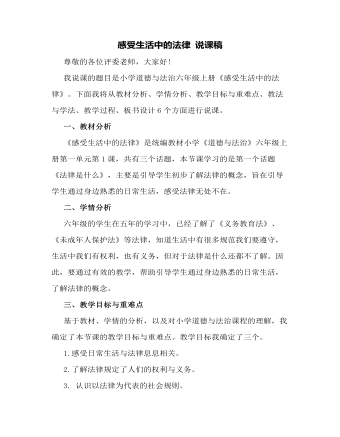
感受生活中的法律 说课稿
一、教材分析《感受生活中的法律》是统编教材小学《道德与法治》六年级上册第一单元第1课,共有三个话题,本节课学习的是第一个话题《法律是什么》,主要是引导学生初步了解法律的概念,旨在引导学生通过身边熟悉的日常生活,感受法律无处不在。二、学情分析六年级的学生在五年的学习中,已经了解了《义务教育法》、《未成年人保护法》等法律,知道生活中有很多规范我们要遵守,生活中我们有权利,也有义务,但对于法律是什么还都不了解。因此,要通过有效的教学,帮助引导学生通过身边熟悉的日常生活,了解法律的概念。三、教学目标与重难点基于教材、学情的分析,以及对小学道德与法治课程的理解,我确定了本节课的教学目标与重难点。教学目标我确定了三个。1.感受日常生活与法律息息相关。2.了解法律规定了人们的权利与义务。3. 认识以法律为代表的社会规则。教学重点是:了解法律是什么。难点是:引导学生理解纪律、道德与法律的关系。

新人教版高中英语必修3Unit 1 Festivals and Celebrations教学设计二
1. Ss look at the picture and scan the passage to understand the main idea while teacher is giving the following questions to inspire Ss to think.*Where are those people?*What are they doing?*Why are they so excited?2. Ss complete the passage with the appropriate -ing form. Then discuss and check the answers with class.Answers: boring, interesting, taking, exciting, amazing3. The teacher raises questions for the students to discuss and encourages them to express their opinions.*Do you like La Tomatina? Why or why not?4. Each group representative reports the discussion result, the teacher gives feedback and the evaluation.Step 6 PracticeActivity 41. Ss complete the Ex 2 in Using structures.2. Check the answers after finishing the exercises.①The dragon boat races are the most exciting part of the Dragon Boat Festival.② The children were excited to go Easter egg hunting.③What an amazing performance! This is the best music festival I have ever been to.④We were amazed by her funny-looking hat.⑤His inspiring speech at the conference won the admiration/ favour of the audience.⑥This is a challenging game to test your memory and observation capabilities. 3. T asks Ss to finish Ex 3 and 4 in Using structures by themselves, then check the answers with class.Step 6 Homework1. Understand and master the functions and usage of the -ing form;2. Finish the other exercises in Using structures.1、通过本节内容学习,学生是否理解和掌握动词-ing形式作定语和表语的功能和意义;2、通过本节内容学习,学生能否在理解文段内容的基础上,根据上下文语境和表达逻辑,能正确运用动词-ing形式描述节日庆典。3、通过本节内容学习,学生是否归纳和积累用于表达情绪的相关词汇。

新人教版高中英语必修3Unit 1 Festivals and Celebrations教学设计一
本板块的活动主题是“谈论节日活动”(Talk about festival activities),主要是从贴近学生日常生活的角度来切入“节日”主题。学生会听到发生在三个国家不同节日场景下的简短对话,对话中的人们正在参与或将要亲历不同的庆祝活动。随着全球化的进程加速,国际交流日益频繁,无论是国人走出国门还是外国友人访问中国,都已成为司空见惯的事情。因此,该板块所选取的三个典型节日场景都是属于跨文化交际语境,不仅每组对话中的人物来自不同的文化背景,对话者的身份和关系也不尽相同。1. Master the new words related to holiday: the lantern, Carnival, costume, dress(sb)up, march, congratulation, congratulate, riddle, ceremony, samba, make - up, after all. 2. To understand the origin of major world festivals and the activities held to celebrate them and the significance of these activities;3. Improve listening comprehension and oral expression of the topic by listening and talking about traditional festivals around the world;4. Improve my understanding of the topic by watching pictures and videos about different traditional festivals around the world;5. Review the common assimilation phenomenon in English phonetics, can distinguish the assimilated phonemes in the natural language flow, and consciously use the assimilation skill in oral expression. Importance:1. Guide students to pay attention to the attitude of the speaker in the process of listening, and identify the relationship between the characters;2. Inspire students to use topic words to describe the festival activities based on their background knowledge. Difficulties:In the process of listening to the correct understanding of the speaker's attitude, accurately identify the relationship between the characters.

新人教版高中英语必修3Unit 2 Morals and Virtues教学设计二
Activity 41. Students complete the task of activity 4, then teachers and students check the answers. 2. The teacher organized the students to work together and asked them to use the tables and mind maps sorted out before to retold the important choices in Lin Qiaozhi's life and their resultsStep 5 Language points1. The teacher asks the students to read the text carefully, find out the core words and long and difficult sentences in the text and draw lines, understand the use of vocabulary, and analyze the structure of long and difficult sentences. 2. The teacher explains and summarizes the usage of core vocabulary and asks the students to take notes. 3. The teacher analyzes and explains the long and difficult sentences that the students don't understand, so that the students can understand them better. Step 6 Homework1. Read the text again, in-depth understanding of the text; 2. Master the use of core vocabulary and understand the long and difficult sentences. 3. Complete relevant exercises in the guide plan. 1、通过本节内容学习,学生是否理解和掌握阅读文本中的新词汇的意义与用法;2、通过本节内容学习,学生能否结合文本特点总结林巧稚的人生原则和人格品质特征;3、通过本节内容学习,学生能否针对人生抉择发表自己的看法;能否全面地、客观地、理性地看待问题,进而对道德和人性有更加深入的思考和理解。

新人教版高中英语必修3Unit 1 Festivals and Celebrations教学设计三
*wide range of origins(= a great number of different origins, many kinds of origins)*It featured a parade and a great feast with music, dancing, and sports. (=A parade and a great feast with music, dancing, and sports were included as important parts of the Egyptian harvest festival.)*.. some traditions may fade away and others may be established.(= Some traditions may disappear gradually, while other new traditions may come into being.)Step 6 Practice(1) Listen and follow the tape.The teacher may remind the students to pay attention to the meaning and usage of the black words in the context, so as to prepare for the completion of the blanks in activity 5 and vocabulary exercises in the exercise book.(2) Students complete the text of activity 5 by themselves.The teacher needs to remind the students to fill in the blanks with the correct form of the vocabulary they have learned in the text.Students exchange their answers with their partners, and then teachers and students check their answers.(3)Finish the Ex in Activity 5 of students’ book.Step 7 Homework1. Read the text again, in-depth understanding of the text;2. Discuss the origin of festivals, the historical changes of related customs, the influence of commercial society on festivals and the connotation and essential meaning of festivals.3. Complete relevant exercises in the guide plan.1、通过本节内容学习,学生是否理解和掌握阅读文本中的新词汇的意义与用法;2、通过本节内容学习,学生能否结合文本特点快速而准确地找到主题句;3、通过本节内容学习,学生能否理清论说文的语篇结构和文本逻辑,了解节日风俗发展与变迁,感悟节日的内涵与意义。

新人教版高中英语必修3Unit 2 Morals and Virtues教学设计三
The joke set her crying.这个玩笑使她哭起来。Step 5 ReadingActivity 31. Students read the small text in activity 3. The teacher provides several small questions to check whether students understand the content of the text and the ideographic function of the -ing form in the text.*Where are those people?*Why did Dr Bethune come to China?*How did he help the Chinese people during the war?*What did Chairman Mao Zedong say about him?2. Ss try to rewrite some sentences using the -ing form. Then check the answers. When checking the answers, the teacher can ask different students to read the rewritten sentences and give comments.Answers:1. he became very interested in medicine, deciding to become a doctor.2. …after hearing that many people were dying in the war.3. Helping to organise hospitals, he taught doctors and nurses, and showed people how to give first aid./ He helped to organise hospitals, teaching doctors and nurses, and showing people how to give first aid.4. …praising Dr Bethune as a hero to be remembered in China.Step 6 PracticeActivity 4Students complete grammar activities 2 and 3 on page 69 of the workbook.Step 6 Homework1. Understand and master the functions and usage of the -ing form;2. Finish the other exercises in Using structures.1、通过本节内容学习,学生是否理解和掌握动词-ing形式作宾语补足语语和状语语的功能和意义;2、通过本节内容学习,学生能否正确使用动词-ing形式描述人物的行为、动作及其经历;3、通过本节内容学习,学生能否独立完成练习册和导学案中的相关练习。

新人教版高中英语必修3Unit 2 Morals and Virtues教学设计四
3.Teachers ask different groups to report the answers to the questions and ask them to try different sentence patterns.The teacher added some sentence patterns for students to refer to when writing.Step 4 Writing taskActivity 51.Write the first draft.Students first review the evaluation criteria in activity 5, and then independently complete the draft according to the outline of activity 4, the answers to the questions listed in the group discussion and report, and the reference sentence pattern.2.Change partners.The teacher guides the students to evaluate their partner's composition according to the checklist of activity 5 and proposes Suggestions for modification.3.Finalize the draft.Based on the peer evaluation, students revise their own compositions and determine the final draft.Finally, through group recommendation, the teacher selects excellent compositions for projection display or reading aloud in class, and gives comments and Suggestions.Step 5 Showing writingActivity 5T call some Ss to share their writing.Step 6 Homework1. Read the passage in this section to better understand the passage.2. Carefully understand the hierarchical structure of the article, and deeply understand the plot of the story according to the causes, process and results;3. Independently complete the relevant exercises in the guide plan.1、通过本节内容学习,学生是否理解和掌握阅读文本中的新词汇的意义与用法;2、通过本节内容学习,学生能否通过人物言行的对比分析道德故事的深层内涵;3、通过本节内容学习,学生能否根据故事的起因、经过和结果来深入理解故事的情节,从而了解文章的层次结构;4、结合现实生活案例发表自己的见解和看法,写一篇观点明确、层次分明的故事评论。

